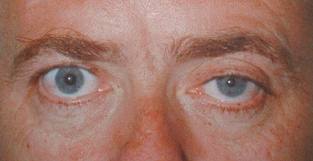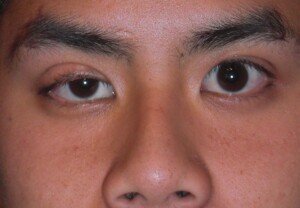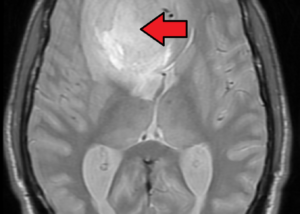Ptosis, as it pertains to symptom of a leaking aneurysm, refers to a drooping eyelid.
The drooping, or ptosis, can have a variety of causes, including a brain aneurysm that has begun to leak.
Another cause of what appears to be eyelid ptosis (perhaps Paris Hilton and Taylor Swift have this?) is “looseness of the skin of the eyelid, causing it to hang down, and even block the visual field,” says Marc I. Leavey, MD, a primary care physician with 40-plus years of experience.
Ptosis can be acquired later in life as well. The ability to control the eyelid involves muscles and nerves.
Eyelid ptosis is divided into four basic classes: myogenic, neurogenic, mechanical and involutional.
- Myogenic (“myo” means muscle) means something is wrong with the muscle of the upper eyelid.
- Neurogenic (“neuro” means nerves/neurons) means that the nerve that supplies the eyelid muscle with movement commands, is impaired.
When the muscles in the eyelid have weakened, the result is involutional ptosis.
Mechanical eyelid drooping is when the weight of the eyelid has become too great for muscular control, and hence, the drooping.
The myogenic version can result from a muscle disease. Neurogenic-caused drooping can be caused by aneurysm, stroke, diabetes, injuries and the dreaded brain tumor.
But Dr. Leavey explains, “Very rarely, tumors or growths in the brain, or leaking or swelling blood vessels in the brain can press on a nerve headed to the eyelid, producing a ptosis.”
As for mechanical ptosis, excess skin, fat and tumors can cause this.
Finally, aging is the primary culprit with involutional ptosis. The muscles and nerves work just fine here, actually.
The problem is when the muscle detaches from the eyelid structures. Thus, the muscle is able to contract, but it’s not attached enough to the eyelid any more to move it.
Ptosis can be corrected with surgery—depending on the cause.
“A key diagnostic question is if the drooping lid is on one side or both,” says Dr. Leavey.
In general, bilateral ptosis is caused by a systemic condition, one that is not specific to the region of one eye, or even the eyes themselves.
“While very uncommon, they include conditions as wide ranging as myasthenia gravis to a whole raft of genetic diseases.”
Miosis simply means a constriction of the eye’s pupil. Miosis is not to be confused with meiosis, which is a type of cell division.
“By itself, unilateral miosis [one eye only] is quite a bit less common; eye drops or other external chemicals can be one cause,” says Dr. Leavey.
If you have one-eye miosis, you should see a physician to rule out a disease process, though if disease is the cause, you’ll very likely have ptosis with it.

Ptosis and miosis. Source: physio-pedia.com
Dr. Leavey continues, “Many sedative drugs, and even deep sleep itself, can cause constricted pupils.”
Being in the dark or dim light and then flipping on bright lights will cause miosis.
One such medical condition, that can cause miosis, is an aneurysm, when it starts leaking.
This does not mean you should become fixated on your pupils and spend time examining them in the mirror because you just read that miosis can be a symptom of a leaking aneurysm.
Additional Information on Aneurysms and Brain Tumors




























